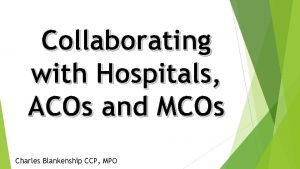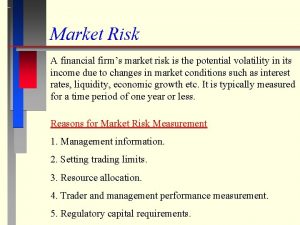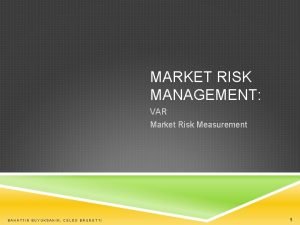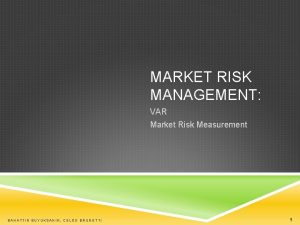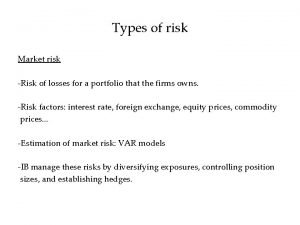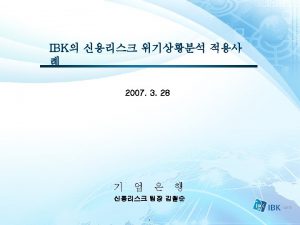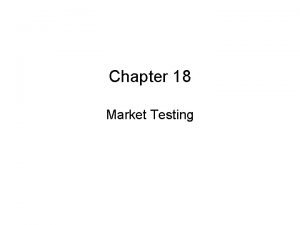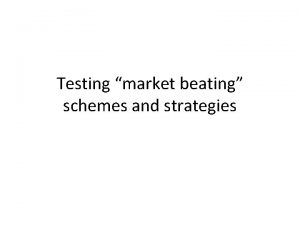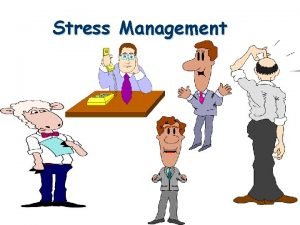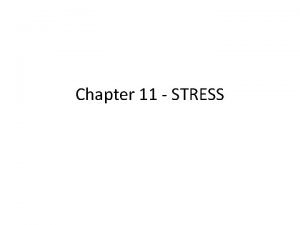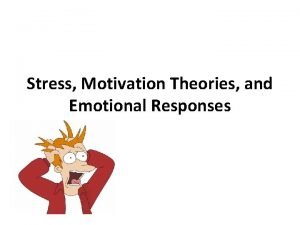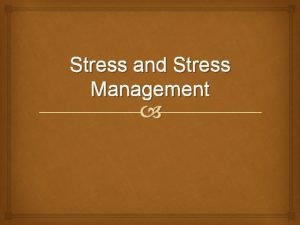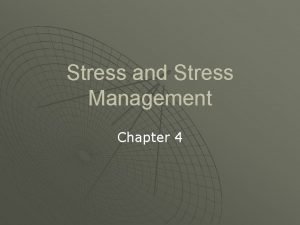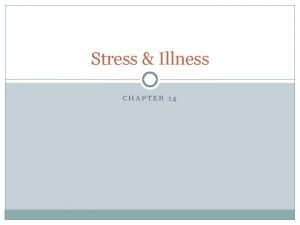Stress Testing for Market Risk Advanced Stress Testing




























- Slides: 28

Stress Testing for Market Risk Advanced Stress Testing Techniques Risk Training New York, Nov 9, 2006 Martin Goldberg Head of Model Validation Risk Architecture Citigroup The analysis and conclusions set forth are those of the authors. Citigroup is not responsible for any statement or conclusion herein, and opinions or theories presented herein do not necessarily reflect the position of the institution. Martin Goldberg, Citigroup - Advanced Stress Testing 9 Nov 2006

Outline ØTypes of Stress Testing q Monte Carlo with calibrated distribution q Named scenarios üHistorical events üHypothetical events q Stressed Distribution q Contagion and Concentration ØQuantile selection ØUse in setting Economic Capital ØCombining Stress Tests, Va. R, and Risk Manager Estimates ØCommunicating results 2 Martin Goldberg, Citigroup - Advanced Stress Testing 9 Nov 2006

Outline ØTypes of Stress Testing q Monte Carlo with calibrated distribution q Named scenarios üHistorical events üHypothetical events q Stressed Distribution q Contagion and Concentration ØQuantile selection ØUse in setting Economic Capital ØCombining Stress Tests, Va. R, and Risk Manager Estimates ØCommunicating results 3 Martin Goldberg, Citigroup - Advanced Stress Testing 9 Nov 2006

Monte Carlo - Calibrated univariate distribution ØNaïve q Use the same historical timeseries as for Va. R (if you use HVAR), or the same covariance matrix (if you use MC Va. R) q Run many times q Result is a bad day in the current market - not actually a stress event ØSomewhat better q Use a univariate distribution with “fat tails” üExamples are Johnson [1], Tukey g×h[2], or Levy[3] üMany more parameters - is it practical? q Run many times - sometimes the worst case for a portfolio is not in the tails of the distribution of any market factor, but at an “interior point” Martin Goldberg, Citigroup - Advanced Stress Testing 9 Nov 2006 4

“Fat Tails” occur frequently in financial markets ØExtreme events in the market occur much more frequently than normal (Gaussian) distributions would predict. ØResultant distribution are “leptokurtic” or have “fat tails” Normal distribution Fat tail event 5 Martin Goldberg, Citigroup - Advanced Stress Testing 9 Nov 2006

Calibrated multivariate distribution ØNaïve q Use the same correlations as for Va. R - equivalent to a Gaussian copula üA Gaussian Copula has zero tail dependence - a very extreme move in one asset is never simultaneous with a similarly big move in any other asset. q This ignores “tail dependence” - also called “contagion” ØSomewhat better q Use a parametric copula with tail dependence üExamples are in Joe’s book[4] üAlmost impossible to extend to high dimensionality q Use the observed historical copula (“empirical copula”) and extrapolate Martin Goldberg, Citigroup - Advanced Stress Testing 9 Nov 2006 q Unclear how to extrapolate if 6 you use HVa. R

Joint market moves can lead to extreme $$$ losses 7 Martin Goldberg, Citigroup - Advanced Stress Testing 9 Nov 2006

Example of Tail Dependence - Brent/ Kerosene 8 Martin Goldberg, Citigroup - Advanced Stress Testing 9 Nov 2006

Shortcomings of using a calibrated MC ØIf the assumed functional form is too simple, there are no stress events generated, or only unrealistic ones ØIf you add parameters, calibration becomes impractical ØThe past may not be a good predictor of future stress events q Stationarity is unlikely for extreme moves ØIf this could be done analytically by even a roomful of Nobel Prize winners, using calibrated MC, then LTCM would still be a powerhouse 9 Martin Goldberg, Citigroup - Advanced Stress Testing 9 Nov 2006

Outline ØTypes of Stress Testing q Monte Carlo with calibrated distribution q Named scenarios üHistorical events üHypothetical events q Stressed Distribution q Contagion and Concentration ØQuantile selection ØUse in setting Economic Capital ØCombining Stress Tests, Va. R, and Risk Manager Estimates ØCommunicating results 10 Martin Goldberg, Citigroup - Advanced Stress Testing 9 Nov 2006

Named Scenarios - Historical ØHistorical means that we look at the impact of past events if they happened again today. However, it needs careful application: q Relative vs. absolute changes q Structural changes in financial environment (e. g. EUR convergence) q New markets ØTypically, named historical scenarios might include q US Stock Crash of 1987 q Russian Default ØThe selection should be appropriate to your portfolio 11 Martin Goldberg, Citigroup - Advanced Stress Testing 9 Nov 2006

Named Scenarios - Hypothetical ØHypothetical means that we propose scenarios that have not necessarily occurred in the past. ØNeeds careful construction. ØMight help to involve economists, traders, etc. in constructing plausible but unlikely scenarios ØExamples (my own ideas - I have no idea if anyone uses these) q US Congress can’t pass budget - US defaults q China invades Taiwan q “Mr Fusion” - free electricity ØBe sure to include knock-on effects on all other markets q Historical correlations are irrelevant here 12 Martin Goldberg, Citigroup - Advanced Stress Testing 9 Nov 2006

Outline ØTypes of Stress Testing q Monte Carlo with calibrated distribution q Named scenarios üHistorical events üHypothetical events q Stressed Distribution q Contagion and Concentration ØQuantile selection ØUse in setting Economic Capital ØCombining Stress Tests, Va. R, and Risk Manager Estimates ØCommunicating results 13 Martin Goldberg, Citigroup - Advanced Stress Testing 9 Nov 2006

Stressed Distributions ØRather than specify the change in each asset for scenarios, this involves “tweaking” the regular Va. R scenario generator q HVa. R üExaggerate the size of selected day’s (or all days’) changes üScaling need not be uniform across assets üDo for as many sets of tweaks as desired q MC Va. R üExaggerate selected volatilites as desired üChange correlations, but must preserve non-negative definite matrix q Run Va. R engine on this stressed dataset ØAdvantage: Easy to implement ØDisadvantage: Difficult to create many plausible but novel stress scenarios with appropriate contagion 14 Martin Goldberg, Citigroup - Advanced Stress Testing 9 Nov 2006

Outline ØTypes of Stress Testing q Monte Carlo with calibrated distribution q Named scenarios üHistorical events üHypothetical events q Stressed Distribution q Contagion and Concentration q. Quantile selection q. Use in setting Economic Capital q. Combining Stress Tests, Va. R, and Risk Manager Estimates q. Communicating results 15 Martin Goldberg, Citigroup - Advanced Stress Testing 9 Nov 2006

Contagion Stress ØIn extreme events, the concept of correlation is as misleading as trying to use volatilities for these sudden jumps and regime shifts ØHistorical relationships may not be relevant in stress events q Do not use historical covariance as a proxy for contagion estimates ØCrashes/Skyrocketing in one asset might be contagious to other assets (“Tail dependence”) anti-contagious (“flight to quality”), or unexpectedly irrelevant (“circuit breakers”) ØAssessing these changes in relationships is more an art than a science 16 Martin Goldberg, Citigroup - Advanced Stress Testing 9 Nov 2006

Concentration Stress ØA different but important kind of stress test is when liquidity changes either alone or simultaneously with price jumps ØIf you have a large exposure that suddenly becomes illiquid, there may be no meaningful price, but your capital is in effect frozen ØA recent concentration stress example is the downfall of Amaranth. q They kept buying the same futures contract as the price went up, but the price was only going up due to their buying. What percent of the liquid float of any given asset does your firm hold? q If you are very long (short) one strategy, what happens if that one collapses? 17 Martin Goldberg, Citigroup - Advanced Stress Testing 9 Nov 2006

Outline ØTypes of Stress Testing q Monte Carlo with calibrated distribution q Named scenarios üHistorical events üHypothetical events q Stressed Distribution q Contagion and Concentration ØQuantile selection ØUse in setting Economic Capital ØCombining Stress Tests, Va. R, and Risk Manager Estimates ØCommunicating results 18 Martin Goldberg, Citigroup - Advanced Stress Testing 9 Nov 2006

How stressful of a stress do you use? ØAlthough much of stress scenario construction is subjective, there are usually corporate guidelines on what they mean by a stress event. q Value at Risk is by definition a 99% worst ten-day event q Basel 2 looks at 99. 9% worst one-year events q AA firms such as Citigroup and JPMorgan. Chase nominally set economic capital as being large enough to withstand 99. 97% worst one-year stress losses ØThe worst year in a thousand is very bad. Stress events of this magnitude might involve revolutions, global political upheavals, and such. No corporation has lasted 10, 000 years, or even 1, 000. 19 Martin Goldberg, Citigroup - Advanced Stress Testing 9 Nov 2006

How stressful of a stress do you really use? ØOften, what the guidelines really mean is that you look at the realized volatility in the recent past, assume it is a stationary lognormal or Gaussian pdf, and scale it up accordingly. ØThis is a difficult question to ask the Policy Committee, but usually someone can indicate what level of stress is appropriate q Ask “them” if they really mean: üSame stress as the crash of 1987 üTen times worse üPrivate ownership of assets is outlawed ØThe various scenarios should be roughly of equal severity so each of them is a meaningful exercise 20 Martin Goldberg, Citigroup - Advanced Stress Testing 9 Nov 2006

Outline ØTypes of Stress Testing q Monte Carlo with calibrated distribution q Named scenarios üHistorical events üHypothetical events q Stressed Distribution q Contagion and Concentration ØQuantile selection ØUse in setting Economic Capital ØCombining Stress Tests, Va. R, and Risk Manager Estimates ØCommunicating results 21 Martin Goldberg, Citigroup - Advanced Stress Testing 9 Nov 2006

Setting Economic Capital ØEconomic capital is defined as the value of assets your firm needs to withstand a specified level of stress losses and still avoid bankruptcy. ØIt could be q Max(Va. R*multiplier, worst stress test result) q Average(Va. R*multiplier, average stress test result) q Etc. q Something even more clever ØThis means that the stress scenarios have to be comparable in magnitude so that it is not clear which scenario will dominate next time. 22 Martin Goldberg, Citigroup - Advanced Stress Testing 9 Nov 2006

Outline ØTypes of Stress Testing q Monte Carlo with calibrated distribution q Named scenarios üHistorical events üHypothetical events q Stressed Distribution q Contagion and Concentration ØQuantile selection ØUse in setting Economic Capital ØCombining Stress Tests, Va. R, and Risk Manager Estimates ØCommunicating results 23 Martin Goldberg, Citigroup - Advanced Stress Testing 9 Nov 2006

Combining Stress Tests, Va. R, and Risk Manager Estimates ØIn some firms, the risk managers periodically give a subjective estimate of how risky their business is, in terms roughly comparable to a narrowly targeted stress test. ØWhen scaling Va. R multipliers, stress tests, and RM estimates to be aggregatable, part of the art form is to not punish desks for hedging against shocks. It may help to compare the impact on random portfolios of the desk’s asset classes rather than on the actual hedged desk holdings, to ensure fairness. 24 Martin Goldberg, Citigroup - Advanced Stress Testing 9 Nov 2006

Outline ØTypes of Stress Testing q Monte Carlo with calibrated distribution q Named scenarios üHistorical events üHypothetical events q Stressed Distribution q Contagion and Concentration ØQuantile selection ØUse in setting Economic Capital ØCombining Stress Tests, Va. R, and Risk Manager Estimates ØCommunicating results 25 Martin Goldberg, Citigroup - Advanced Stress Testing 9 Nov 2006

Communicating results ØPart of the stressing process is to try to safeguard against desks gaming the specifics of the scenarios, so some secrecy may be desirable. ØPart of the process is analyzing the results to point out weak areas, inadvertent side bets, and helping to decide where extra hedging or diversification might be warranted. This is where the process adds the most value. ØSenior management, the desks, and the regulators all may have a keen interest in some or all of the results, presented in some digestible form - this too is an art. 26 Martin Goldberg, Citigroup - Advanced Stress Testing 9 Nov 2006

Conclusions ØStress testing is not easy ØFormulaic approaches are not optimal ØThe past may not be a good proxy for the future ØDecide what level of stress to aim for ØUse multiple scenarios and kinds of stress test, but make them comparable in stressfulness ØBe creative in designing, and get economists and research involved in designing the tests ØKnow your audience 27 Martin Goldberg, Citigroup - Advanced Stress Testing 9 Nov 2006

References 1. Johnson NL, Kotz S (1970), Distributions in Statistics: Continuous Univariate Distributions - 1, John Wiley & Sons, NY 2. http: //fic. wharton. upenn. edu/fic/papers/02/0225. pdf and http: //fic. wharton. upenn. edu/fic/papers/02/0226. pdf 3. 4. http: //en. wikipedia. org/wiki/Levy_distribution H. Joe, “Multivariate Models and Dependence Concepts” Chapman&Hall, 1997 28 Martin Goldberg, Citigroup - Advanced Stress Testing 9 Nov 2006
 Credit risk market risk operational risk
Credit risk market risk operational risk Leader follower challenger nicher
Leader follower challenger nicher Market segmentation objectives
Market segmentation objectives Milliman advanced risk adjusters
Milliman advanced risk adjusters Advanced topics in software engineering
Advanced topics in software engineering Advanced software testing concepts
Advanced software testing concepts Engineering vs true stress strain curve
Engineering vs true stress strain curve What is the definition of axial stress
What is the definition of axial stress Chapter 10 stress responses and stress management
Chapter 10 stress responses and stress management Workplace risk assessment hertfordshire
Workplace risk assessment hertfordshire Fspos
Fspos Novell typiska drag
Novell typiska drag Tack för att ni lyssnade bild
Tack för att ni lyssnade bild Returpilarna
Returpilarna Shingelfrisyren
Shingelfrisyren En lathund för arbete med kontinuitetshantering
En lathund för arbete med kontinuitetshantering Kassaregister ideell förening
Kassaregister ideell förening Tidbok för yrkesförare
Tidbok för yrkesförare Sura för anatom
Sura för anatom Förklara densitet för barn
Förklara densitet för barn Datorkunskap för nybörjare
Datorkunskap för nybörjare Boverket ka
Boverket ka Debattartikel struktur
Debattartikel struktur Delegerande ledarskap
Delegerande ledarskap Nyckelkompetenser för livslångt lärande
Nyckelkompetenser för livslångt lärande Påbyggnader för flakfordon
Påbyggnader för flakfordon Tryck formel
Tryck formel Svenskt ramverk för digital samverkan
Svenskt ramverk för digital samverkan Jag har nigit för nymånens skära
Jag har nigit för nymånens skära



